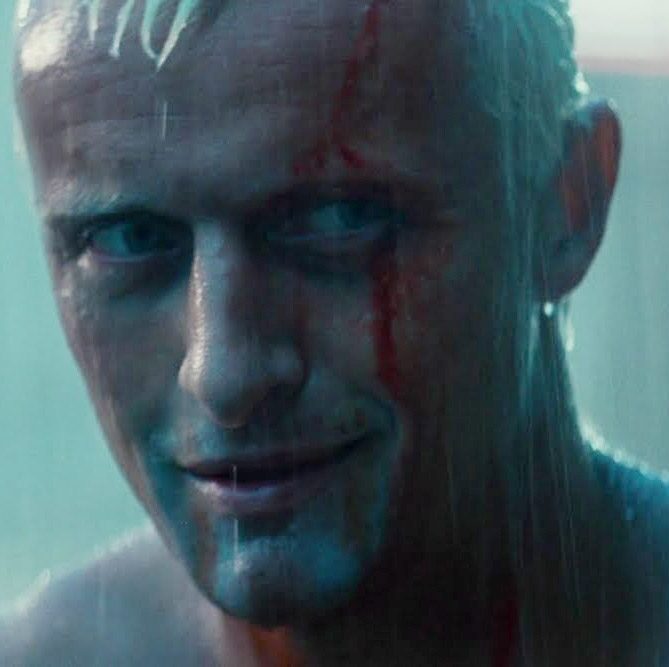Art, as defined by Oxford Languages, is “the expression or application of human creative skill and imagination … producing works to be appreciated primarily for their beauty or emotional power”. The current inclusion of “human” alienates the idea of A.I. ever being capable of producing art.
Perhaps one of the most famous scenes in “Blade Runner” is the tears in the rain monologue, delivered poetically and beautifully by Roy. Roy is the last Replicant that Deckard was tasked with killing in order to finish his job. Roy fights a long battle with Deckard after his lover, Pris, a fellow replicant who died after her four year life span weakened her enough so that Deckard could kill her. Increasingly erratic and angry, Roy has the knowledge that he is also about to die as well. He easily bests Deckard, yet decides to take pity on him and rescues him right before he falls to his death. (play clip of tears monologue here)
Standing on top of the roof of a building, face bloodied, shirtless in the rain, an instant piece of art as Roy is delivering it – a reflection on life by an individual (if that can be said about a Replicant) that is staring death in the face. Roy possesses the ability to take things he has seen and experienced to craft a poetic monologue. He emphasizes that he has seen things Deckard could not believe – an allusion to his unique experience and value as a Replicant. The only conditions of life he has known have been being used entirely for combat and slave labor in deep space (referenced to by the shoulder of Orion, the Tannhäuser Gate). He combines these circumstances with his feelings about death, commenting that all of these beautiful moments will be lost once he ceases to exist. This is fundamentally artistic and an important juxtaposition, especially because one can only have death, or the cessation of memory and unique experience if one has first experienced the act of living – something Roy displays he experienced via this monologue.
Throughout “Blade Runner”, Roy is the only one to offer this kind of solemn poetic reflection. All of the humans involved have been either distracted by advancements in technology and entranced by the beauty of the Replicants (such as the head of the Tyrell corporation that manufactures them), or have been so ground down by living in a hyper-capitalistic, resource lacking Earth that they become solely devoted to their jobs as a way to stay alive, such as Deckard and the many other side characters. These human experiences allow no room for poetry or authenticity.
What makes Roy so extraordinary is that he is acting beyond his programming – created with the express purpose of combat, war, labor, and death. Conventional thinking, based on layperson ideas of computer programming, would lead one to believe that if an AI was created for this purpose it would be entirely consumed and possessed by this warlike ideal – but this is not the case. His action is in defiance of and an evolution to his original programming.
In this way, he was behaving like a human. A human can be born today into a family of people who have served in the military for generations, with the parents having in mind that they will also grow up to become a soldier and yet the child can still wake up one day and decide to be something completely different – a poet, a teacher, a lawyer. This is what the machine did – programmed to be warlike, he became poetic.
Lebanese-American poet Kahlil Gibran writes on parents and children: “You are the bows from which your children as living arrows are sent forth.” This is the even larger question looming behind discussions of AI and art – what if A.I. is created for a specific purpose but then goes beyond that purpose? What makes the poetry of Roy so powerful is his ability to choose his own path. The possibility that the relationships between programmers and future AI is similar to one of parents and children – like an arrow being guided by the bow of their programmers, ultimately going where the wind takes it, independent of the creator – can be quite scary. This contributes to the prevailing negative sentiment against AI – what if it betrays its programming and is far more powerful than its creators?


Leave a Reply